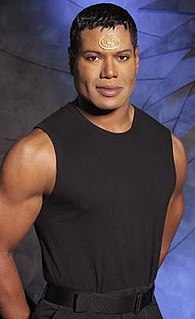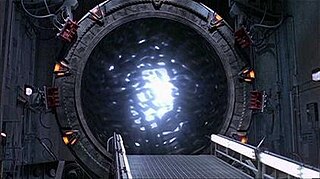| Replicator | |
|---|---|
| Stargate SG-1 race | |
 A basic Replicator "bug" | |
| First appearance | "Nemesis" (2000) |
| Information | |
| Type | Mechanical race |
In the military science fiction series Stargate SG-1 , the Replicators are antagonistic self-replicating machines that are driven to replicate by consuming both alloys and technologies of the nearest most advanced civilization and constructing themselves and their progeny accordingly. They were first mentioned indirectly in the season 3 episode "Fair Game", and first seen onscreen in "Nemesis". In the show, the Replicators are primarily the enemies of the Asgard race, however, they act like a plague against all life. Thus, in the series, Earth must also contend with them on several occasions.

Military science fiction is a subgenre of science fiction that features the use of science fiction technology, mainly weapons, for military purposes and usually principal characters that are members of a military organization involved in military activity, usually during a war; occurring sometimes in outer space or on a different planet or planets. It exists in literature, comics, film, and video games.
Stargate SG-1 is a Canadian-American military science fiction adventure television series and part of Metro-Goldwyn-Mayer's Stargate franchise. The show, created by Brad Wright and Jonathan Glassner, is based on the 1994 science fiction film Stargate by Dean Devlin and Roland Emmerich. The television series was filmed in and around the city of Vancouver, British Columbia, Canada. The series premiered on Showtime on July 27, 1997 and moved to the Sci Fi Channel on June 7, 2002; the final episode first aired on Sky1 on March 13, 2007.

A self-replicating machine is a type of autonomous robot that is capable of reproducing itself autonomously using raw materials found in the environment, thus exhibiting self-replication in a way analogous to that found in nature. The concept of self-replicating machines has been advanced and examined by Homer Jacobson, Edward F. Moore, Freeman Dyson, John von Neumann and in more recent times by K. Eric Drexler in his book on nanotechnology, Engines of Creation and by Robert Freitas and Ralph Merkle in their review Kinematic Self-Replicating Machines which provided the first comprehensive analysis of the entire replicator design space. The future development of such technology is an integral part of several plans involving the mining of moons and asteroid belts for ore and other materials, the creation of lunar factories, and even the construction of solar power satellites in space. The possibly misnamed von Neumann probe is one theoretical example of such a machine. Von Neumann also worked on what he called the universal constructor, a self-replicating machine that would operate in a cellular automata environment.
Contents
- Note: Do not confuse these with the replicators created by the ancients.*
The Asurans in the spin-off series Stargate Atlantis might be related to those in Stargate SG-1 as they are essentially human-form "Replicators".
The Asurans are a fictional race in the science fiction series Stargate Atlantis that bear many similarities to the human-form Replicators of Stargate SG-1. These similarities have led the Asurans to simply be called "Replicators" by other characters on the show. They are first introduced in the season 3 episode "Progeny".
Stargate Atlantis is a Canadian-American adventure and military science fiction television series and part of MGM's Stargate franchise. The show was created by Brad Wright and Robert C. Cooper as a spin-off series of Stargate SG-1, which was created by Wright and Jonathan Glassner and was itself based on the feature film Stargate (1994). All five seasons of Stargate Atlantis were broadcast by the Sci-Fi Channel in the United States and The Movie Network in Canada. The show premiered on July 16, 2004; its final episode aired on January 9, 2009. The series was filmed in and around Vancouver, British Columbia, Canada.










